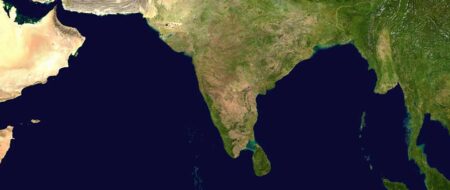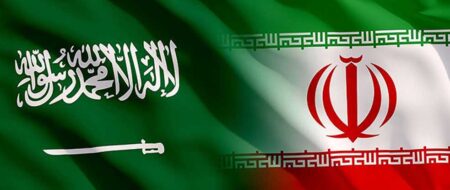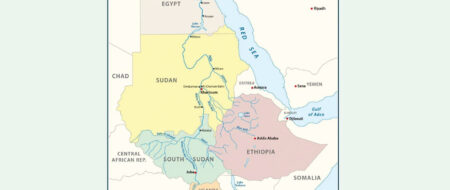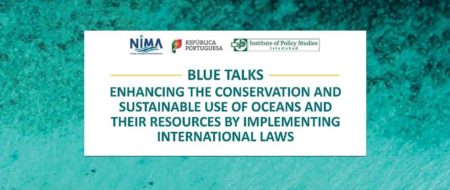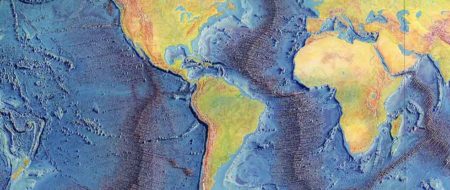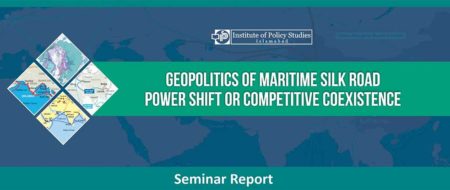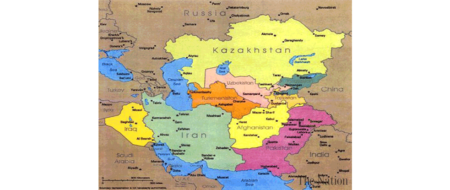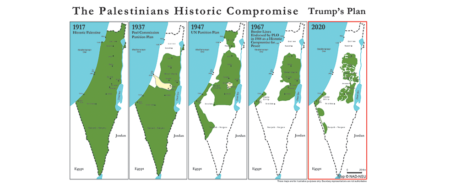Obama’s Middle East Initiative A Comparative Analysis
Since 1967 Middle East – as a region has been a test of US’ commitments to its allies on one hand and commitment to liberal values that form its very basis; on the other.
Policy Perspectives , Volume7 , Number 1, Special Issue 2010
Abstract
[Since 1967 Middle East – as a region has been a test of US’ commitments to its allies on one hand and commitment to liberal values that form its very basis; on the other. Since then, the subsequent US’ Presidents have enunciated their respective Middle East policies in landmark speeches, in an effort to stabilize the region and resolve the Israel-Palestine issue, that has plagued the region since Israel’s inception in 1948. Obama’s Middle East policy is expected by many to bear some fruit, particularly after his landmark speech in Cairo on June 4, 2009, which was termed “a new beginning”.
This paper primarily intends to examine whether Obama’s initiative is novel enough and how pragmatic or practical it appears in light of past initiatives of his predecessors. Here a comparative analysis shall be made in light of the policies, as outlined in speeches of the US’ Presidents. The very theme of the paper enhances its significance as all eyes are set on President Obama for some substantial move in direction of peaceful settlement of the Palestinian issue in particular and Middle East’s stability in general – Ed]
Introduction
Middle East as a region holds strategic significance for US’ foreign policy goals. Access to low-priced energy supplies, protection and support for Israel, a key US’ ally in the region, and control of the routes essential for trade and maintaining regional hegemony are some of its top priorities. The fact that the most revered holy centers of the world’s three largest religions lie here grants the region additional significance. These factors make this region indispensable to US foreign policy objectives.
President Obama assumed office at a crucial time when Middle East presented a checkered scenario. Time between Obama’s election and oath-taking was marked by Israel’s Gaza invasion that added fuel to already rampant anti-American and anti-Israel sentiments in the region. Since the Israeli-US relationship is generally seen as a litmus test of US behavior in the region1, the new administration was presented with the task of maintaining alliance with two opposite camps—Israel and the Arabs, softening the Arab resentment towards Israel, and curtailing the anti-Americanism ensuing not only from unequivocal American support to Israel, but from invasions of Muslim countries, the hundreds of thousands of civilian casualties in the aftermath of 9/11, and the post invasion turmoil in the invaded countries as well. Although courting regimes never required much craft in general, the real issue remained the anti-American sentiments at popular level.
Nevertheless, a few developments in the region did provide the new administration with a baton to counter the prevailing challenges. In Iraq—that had been the hotspot in Middle East since 2003—the situation was getting better after a bloody war and there was talk of US withdrawal. The details of pulling out American forces from Iraq were outlined in an agreement between US and Iraqi regime known as ‘Status of Forces Agreement’ (SOFA) in November 20082. As far as Iran is concerned, it was tacitly helping US in Iraq and Afghanistan. Although Tehran continued maintaining an anti-US posture, it was cognizant of its gains in the form of conducive environment for enhancing its influence with the Shiite majority in Iraq after US invasion ousted Sadam who had been a constant source of worry for Iranians. In Afghanistan too, it cooperated with US in orchestrating the Karzai government at the Bonn conference of December 2001.3
Amidst these developments, Barack Obama’s arrival in the White House was expected to herald an epoch of ‘change’, a slogan very shrewdly chosen in line with the changing dynamics in international politics, particularly the Middle East. Obama’s success in elections is a testimony to peoples’ longing for change. Change, however follows or not, is yet to unfold.
Predictably, President Obama made a mention of his ‘new initiative’ for Middle East in his first interview with the Arabic news network, Al Arabiya, after becoming president, which was later on presented comprehensively in the form of much awaited “Cairo speech”, generally labeled by media pundits as ‘a historic turning point’.4 It was taken as ushering in a new era in Middle East politics and the slogan of ‘change’ was expected to make headway on the road to implementation. It is, therefore, important to see how Obama addresses the Palestine problem as the core issue of the region in particular and other peripheral issues of the contemporary Middle East.
Obama’s Initiative
The much anticipated Cairo speech5 enunciated “America’s strong bonds with Israel” that was based “upon cultural and historical ties and the recognition that the aspiration for a Jewish homeland is rooted in a tragic history that cannot be denied.” In passionate words empathetic language, the 44th American president presented Israel’s case and its right to exist as a Jewish State in Palestinian land, saying:
Around the world the Jewish people were persecuted for centuries. And anti-Semitism in Europe culminated in an unprecedented holocaust … Threatening Israel with destruction or repeating vile stereotypes about Jews is deeply wrong and only serves to evoke in the minds of the Israelis this most painful of memories.
President Obama also talked about the Palestinian people who “have suffered in pursuit of a homeland” and “endured the pain of dislocation … the daily humiliations, large and small, that come with occupation.” He tried to assure Palestinian people that “America will not turn our backs on the legitimate Palestinian aspiration for dignity, opportunity and a state of their own.” Obama deplored the stalemate and marked that “the only resolution is for the aspirations of both sides to be met through two states, where Israelis and Palestinians each live in peace and security.”
The parties involved were asked to honor the commitments made in the 2003 Road Map and demands were made to end violence and govern effectively from the Palestinian side, particularly Hamas. Palestinians were also required to take all necessary steps to reduce negative sentiments against Israel and prepare grounds for normalization of relations between Israel and the Palestinian entity in all sectors.
Both parties were asked to recognize other’s right to exist. Israel was asked to take steps to improve the daily lives of Palestinians, in reference to countless security checks that hamper free movement of Palestinians. The contentious Israeli settlements were dubbed “illegal”, “an impediment to peace”, and a “violation of previous agreements”. Obama, while recognizing King Abdullah’s Arab peace initiative, asked all—Arabs and others alike—to be supportive of two-state solution. He stressed that conflict with Israel shouldn’t be used as a means to distract attention of Arab people from such regional issues.
However concerned Obama seemed at Cairo, he failed to refer to UN resolutions, specifically resolution 242 (passed in 1967) and 338 (passed in 1973) that had been accepted by the US as the guiding principles for any future settlement of the issue. It is also interesting to note here that Obama first talks about Israel’s tragic history and Third Reich’s oppressive treatments with Jews but when it comes to fulfilling obligations and responsibilities for reaching solution to Palestine problem, Palestinians take precedence as if the onus of present turmoil lies not on the Jewish occupation of Palestinian land but on the Palestinians for the most part. Besides, the gory Gaza conflict that marked the beginning of year 2009 and claimed hundreds of innocent lives was mentioned as a passing reference by the US President.
Besides addressing the core issue of the Middle East, Obama’s Initiative also touched upon other peripheral issues in the region such as the situation in Iraq, Iran’s nuclear program and commitment to democracy, women rights and religious freedom. President Obama claimed that the “US has no claim on Iraqi resources”, or “wish of having bases here” and reiterated his plan of withdrawing combat brigades by July 2010 and all forces by 2012. In case of Iran, the Cairo speech reiterated his willingness to proceed with Iran on basis of “mutual interest”, “without preconditions”. It was made clear that US recognized Iran’s right to peaceful nuclear energy provided “it complies with its responsibilities under the Nuclear Non-Proliferation Treaty.” President Obama also confessed American role in ousting the democratically elected Mosaddeq regime in 1953-coup, implying that such past conduct on part of his country was responsible in deteriorating US-Iranian relations.6
In the context of current precarious situation in the region, it is imperative to ask whether President Obama’s initiative is really a beginning of substantial change or following the ways of past American Presidents. The answer to this lies in the retrospect. To gauge the novelty of Obama’s Middle East initiative, it is pertinent to have a look at the initiatives launched by Obama’s predecessors in reference to Palestine issue in particular and Middle East in general. The outcomes of past initiatives would make it possible to understand the likely future scenario.
Past Presidents’ Initiatives
Regional and International Environment: Since the beginning of Cold War, the subsequent US administrations had seen the Middle East in context of the international political environment, making the region an arena of superpower rivalry for influence, strategic advantage and access to oil. This approach effectively ignored the internal dynamics of the region. Generally speaking, from Eisenhower (1953–1961) to Reagan (1981–1989), containing Soviet Union was the prime objective of US Middle East policy. Considering Israel’s performance in the 1967 Arab-Israeli conflict, the Nixon administration (1969–1974) thought the conversion of US-Israeli relationship into a strategic partnership would guarantee America’s prime regional interest.7 After the 1973 war and the collective oil embargo on the West by Arab States, Carter (1977–1981) assumed office in White House with the slogan of giving Arab-Israeli conflict a fresh approach. He furthered the process of talks between Egypt and Israel and Israel and Syria via Camp David (1978) and Egypt-Israel peace treaty (1979). Israel’s intransigence in terms of fulfilling these commitments led to diminish trust in the mediation efforts.
By the time President Reagan ascended to power, the regional and international scenario changed with the Iran-Iraq war in the Gulf and Soviet invasion of Afghanistan. So, unlike Carter, Reagan was less enthusiastic about the Palestine issue. Once again the globalist approach towards Middle East overshadowed the regionalist perspective.8 However the 1982 Lebanon war once again brought home the potential of Palestine issue to affect regional peace. Efforts of peace again failed and just like Nixon, Reagan deemed Israel as a reliable ally.
Following the end of Cold War George H W Bush (1989-1993) inherited a triumphant US. Being a sole superpower without the fear of rivalry, it had the opportunity to settle the regional disputes. But the US got itself bogged down in the Gulf War of 1991. To the general public in the Middle East, however, the unprecedented proactive US approach towards solving Kuwait Crisis that was perceived to have possibly been addressed through negotiations and dialogues, was in sharp contrast to the almost inactiveness of the US towards solving the decades old Palestine issue. Countering these sentiments, the Bush Sr. administration launched a peace process that was led on by President Clinton (1993-2001) who came into power with a renewed spirit to resolve the Arab-Israel dispute. Although negotiations and accords were orchestrated yet peace remained elusive and the process failed to bring any breakthrough.
With the radical neo-conservatives in power under the George W. Bush administration (2001-2009) and the incident of 9/11, the euphoric moments for US unfortunately ended with the ‘terrorist threat’ replacing the ‘Red Army’. America was once again engaged in a global war ensued with the aim of hunting down the ‘faceless’ enemy. Conflicts in the Middle East were now defined in terms of ‘terrorists versus the moderates’. Once again, US policy for the region became a mere extension of its counter-terror strategy that interpreted the local disputes in the same context. Another invasion of Iraq allowed the then American president to pronounce loudly that “the world is better off without Saddam Hussein”9 but the Middle East was still worse off with the bleeding Palestine issue. The déjà vu of US proactive action against Iraq contrasted again with American support to Israel for invading its neighbors. These hawkish policies of Bush administration gave rise to widespread anti-American sentiments in the Middle East in particular and in the Muslim World in general.
In short, the subsequent US presidents adopted certain policy approaches keeping in view certain regional and international environment of their times. Sometimes the international factors drove the US approaches in Middle East and some other times regional developments became the reasons for certain initiatives. In this context, it is significant to examine the former US presidents’ initiatives towards the issues that President Obama talked about in his Cairo speech and the results of their efforts.
Palestine Problem – the Core Issue: The first year of George W Bush’s presidency witnessed the seminal 9/11. The result being, his policies towards every region were shaped in the mould of his declared war on terrorism. Middle East, for reasons very obvious, was no exception. Bush’s policies will always be associated with his ‘either with us or with the terrorists”10 statement. These demands of choosing between the two camps of ‘civilized world’ and ‘terrorists’ were also made to the Middle Eastern countries, especially, Syria, Iran and Palestine in reference to their backing of Hezbollah, Hamas and other declared terrorist outfits by US.
Amid this, Bush was able to give his solution to the Palestine issue that came to be known as ‘Road Map for Peace in Middle East’.11 This landmark speech gave the two-state solution, “living side by side in peace and security”. Palestinian authority was also asked to “stop inciting violence by glorifying terror in state-owned media”, because that hinders the peace process.12 A reference was made to King Abdullah’s Arab peace initiative by saying that it could be a hopeful moment in the Middle East since this initiative was close to recognition of Israel by Arabs. Bush had also explicitly expressed his commitment to Israel’s security.13
Bush, however, categorically said here that “Israeli settlements in occupied Palestinian territories must stop”, consistent with the Mitchell plan14 and Israeli forces must withdraw to secure borders in line with UN resolutions 242 and 338.15 He also asked Israel to halt incursions into Palestinian controlled areas, and also withdraw from the places it had occupied in the aftermath of second Palestinian Intifada launched in 2000.16
Before George W Bush, President Bill Clinton started his tenure with an enthusiasm about making headway in the Palestine issue. Since Clinton administration was not facing the menace of Cold War, it was assumed that conditions were conducive to permanent settlement of the issues in the region. His era was marked with peace talks and negotiations, yet no permanent solution could be reached.
Clinton also considered Israel’s security a top priority and he maintained that ‘regional peace’ was conditional on ‘Israel’s security’.17 His support for Israel seemed even more unequivocal when he said:
Lasting peace in the region is the key to Israel’s security, something to what US is thoroughly committed … US would do that [enhance Israel’s security] by further reinforcing its commitment to maintaining Israel’s military edge in the region.18
The talks between the two sides encompassed the idea of two-state solution in line with UN resolutions 242 and 338, mutual recognition between Palestinians and Israel, recognition of the latter by Arabs leading to normalization of relations between them.19 Clinton also asked the Palestinians to stop glorifying terrorism in statement made during Clinton’s address to Palestinian National Council in Gaza on December 14’1998:
Every influential Palestinian, from teacher to journalist, from politician to community leader, must make this a mission to banish from the minds of children glorifying suicide bombers; to end the practice of speaking peace in one place and preaching hatred in another; to teach school children the value of peace and the waste of war; to break the cycle of violence.20
Clinton, however, failed to acknowledge the contentiousness of Israel’s settlements on occupied territories. In fact, he proposed the incorporation of as many settlement blocks into Israel as possible in his famous ‘Clinton Peace Parameters’.21 In one of the statements, he talked about Israel’s settlements in the following words:
The incorporation into Israel of settlement blocks, with the goal of maximizing the number of settlers in Israel while minimizing the land annex for Palestine.22
All he could manage to say to compensate Palestinians in his speech at the occasion was that the settlements were ‘inconsistent with the Oslo commitment’.23 Putting aside the practical measures to halt settlements, Clinton never conveyed the illegality of these. The Oslo Accord under Clinton very craftily ignored the issue of settlements. Even, the Camp David summit suffered an impasse because the issue of settlements was not paid attention to. He merely termed the settlement issue as being ‘obstacle to peace’.24
Going further back to his predecessor, George H W Bush might have ruled the most powerful America in its entire history, yet illegality of settlements was never outrightly accepted by his administration. There was an instance when senior Bush was asked to comment on a statement made by James A. Baker, his secretary of state where the latter had referred to Jewish settlements on occupied territories as being ‘obstacle to peace’,25 the President only indirectly subscribed to the idea when he said that “Secretary Baker was speaking for this administration. And I strongly support what he said … it would make a big contribution to peace if these settlements would stop.”26
President Ronald Reagan administration (1981-1989) was not much different in this regard: no talk of illegality but a “freeze” to settlements was demanded in the Regan plan of 1982 that categorically marked:
The United States will not support the use of any additional land for the purpose of settlements during the transition period. Indeed, the immediate adoption of a settlement freeze by Israel, more than any other action, could create the confidence needed for wider participation in these talks. Further settlement activity is in no way necessary for the security of Israel and only diminishes the confidence of the Arabs and a final outcome can be freely and fairly negotiated.27
However, there was no concept of two-state solution; rather the idea of ‘self-government by the Palestinians of the West Bank and Gaza in association with Jordan’28 was propagated.
Here President Jimmy Carter stands out since he clearly labeled the settlements illegal.29 In an interview, he very explicitly said:
Our position on the settlements is very clear. We do not think they are legal.
Lyndon B Johnson, Richard Nixon, Gerald R Ford and Carter administrations used to maintain that the settlements are illegal by alluding to the Article 49, Paragraph 6 of Fourth Geneva Convention.30
Thus, the stance adopted by President Obama that Israel’s settlements on occupied territories are illegal was iterated by former presidents as well. The Secretary of State, Hillary Clinton reinforced America’s 40-year opposition to Israeli settlement and rejection of the ‘legitimacy of continued Israeli settlements’31 in her visit to Middle East in November 2009.
Needless to say that settlement issue is only the tip of the iceberg in the entire Palestine issue, yet it is consuming most of the efforts of American presidents. There are other very important aspects to this issue such as the right of return for the Palestinian refugees, the issue of Jerusalem, Israeli incursions into Palestinian territory, its potential to escalate into war-like situations or the dire need to move towards the final solution.
Other Peripheral Issues: After comparing the approaches of former US presidents with that of Obama’s Initiative with respect to the core issue of the Middle East, it is pertinent to briefly examine the policies of former US administrations towards other peripheral issues concerning the region, namely Iraq, Iran and values, mentioned by President Obama in his Cairo speech.
Iraq: For quite some time, Iraq has been the focus of US Middle East policies for various reasons in different times. During the Iran-Iraq war, Reagan administration supported Saddam to undermine the regional standing of post-revolutionary Iran, and to curb its chances of exporting its revolution abroad. It was considered as a shift in American approach towards Iraq as it had belonged to the rival bloc all through the Cold War. However, the Gulf war of 1991 that initiated the Iraq-dilemma following its invasion of Kuwait. Many a times, Bush Sr. is criticized for leaving ‘the unfinished business’ of toppling Saddam. Since the Kuwait crisis, Iraq has been a centre of values-laden rhetoric emanating from the White House—values of freedom, democracy, justice etc. Manipulating the environment against Iraq, Clinton administration went as far as keeping Iraq under continuous missile attacks for deterring Sadam’s pursuit of Weapons of Mass Destruction (WMD). Bill Clinton was also criticized for not taking measures to bring down Saddam’s regime. Ironically, American commitment to ‘freedom’ and ‘liberty’ encouraged President Bush Jr. to ‘conquer’ Iraq on the pretext of fighting terrorism, dictatorship and ridding of WMD in the 2003. He termed Saddam Hussein as ‘an enemy of the United States’ because ‘he attacked his neighbors’ and ‘he was paying Palestinian suicide bombers’.32
In this background, it is interesting to note here that Obama’s speech does not bring to fore significantly deviant postures on how best to handle Iraq as the incumbent could not deviate much from his predecessor, especially regarding the troop withdrawal strategy. In an agreement concluded between the US and Iraqi regimes in mid November 2008, it was agreed that all the US forces shall withdraw from Iraq no later than December 31, 2011 and the combat forces no later than June 30, 2009,33 whereas President Obama had promised during his presidential campaign that combat troop withdrawal will take place within sixteen months of his assuming responsibilities.34 At Cairo, Obama pledged that ‘US shall withdraw its combat brigades from Iraqi cities by July 2010 and all forces by 2012.’ The two strategies do not appear to be much different.
The only thing that could qualify to be called different was Obama’s labeling Afghanistan as the central front, rather than Iraq, in the war on terror. However, one must also note that the idea of troop surge in Afghanistan too was not a brainchild of Obama, as President Bush had already proposed that in his speech on September 9, 2008 at US National Defense University.35
In Iraq, Obama’s responsibilities are far greater than his predecessor. The future shape and political stability of Iraq and the credibility of its regime in the eyes of Iraqis after US leaves are factors that shall gauge his performance here.
Iran: Iran also became a target of President Bush’s harsh policies. 9/11 made the international scenario conducive enough for the US to brand Iran as part of the axis of evil states and to condemn it for its backing of Hamas and Hezbollah.36 In 2006, during Israel’s assault on Lebanon, US blamed Iran for inflicting instability in Lebanon and Hezbollah’s strength in contrast to the government,37 not to mention its frequent reference in relation to terrorism and destabilizing role in Iraq.
Bush’s policies centered on isolating Iran in the region yet it had resorted to negotiations on the nuclear issue with latter that only ended in sanctions against the Iran. The US policy at that time was contrary to US regional interests in post-2003 scenario in the region. Considering Iran’s influence with the Iraq’s Shiite majority, courting Iran would have definitely benefited US, but George Bush had his Iran-policy set in line with the anti-Iran stance maintained by all successive US’ Presidents since President Carter. It was basically President Reagan who took a U-turn in US-Iran relation and set the course for strict policies towards Iran.
However, prior to the Islamic Revolution, Iran was the regional policeman and caretaker of US interests in the Gulf. In the words of President Carter, Iran was ‘an island of stability in one of the more troubled areas of the world’38 primarily because the dictatorial regime in Iran at the time guaranteed to safeguard the American regional interests. That explains US backing of dictatorial Shah in face of democratically elected nationalist-minded Mosaddeq. The latter was a serious threat to major powers’ hold of Iranian oil resources. Keeping that in mind, the Eisenhower administration undertook what Harry S Truman was hesitant about39 and assisted the coup against democratic regime with an agreement that guaranteed ‘effective control of oil production and marketing and 50 percent of the profits in the hands of the world oil cartel companies.’ 40
In this backdrop, President Obama’s goodwill message to Iranians on Neiroz, offers of ‘unconditional talks’, a reference to US foreign policy blunders such as the 1953 coup,41 and the recognition of Iran’s right to peaceful nuclear energy provided it complies with NPT provisions are very important gestures from White House. Nevertheless, Iran alleged the US and its Western allies for exploiting the unrest in Iran ensuing from Iranian presidential elections. This development muddied the already debased political environment between the two countries. Also, noteworthy is the fact that President Obama has initiated the campaign of putting sanctions on Iran, same as his predecessor Bush Jr. did in collusion with his European allies.42
Values: Ironically enough, almost all the US invasions, sanctions against various countries and formation of military alliances were claimed to further Democracy, women rights, equal right, religious freedom, education so on and so forth. Rhetoric of US commitment to these values could be traced back to George Washington.43 The most radical of US presidents, Georoge W Bush, also talked about promoting democracy, freedom, liberty, and human rights continuously as the objective of waging war against Iraq even though the international community was sure that real objectives behind Iraq War could be anything but those declared by Bush administration, as evidenced by the mass protests against Iraq War around the world. Paradoxically, President Obama also talks of promoting these values in the Arab world while standing at a place where state of emergency has not been lifted since 1967. One of the most practical reasons behind this contradiction in speech and action may be found in George Kennan’s44 policy advice to Washington when he says:
We should dispense with the aspiration to “be liked” or to be regarded as the repository of a high-minded international altruism. We should stop putting ourselves in the position of being our brothers’ keeper and refrain from offering moral and ideological advice. We should cease to talk about vague and … unreal objectives such as human rights, the raising of the living standards, and democratization. The day is not far off when we are going to have to deal in straight power concepts. The less we are then hampered by idealistic slogans, the better.45
Conclusion
The sole intention behind making a comparison between Obama’s initiative and those put forward by his predecessors was to underscore whether the flag bearer of change has put forward something revolutionary or, to say the least, launch an initiative in every sense of the word, particularly in relation to the Israel-Palestine issue that happens to be the core issue in the region.
In this context, Obama’s rhetoric and policies seem to be the replication of decades old tradition of giving lip-service to the ‘illegality of settlements’, demands of ‘abiding by the agreements and resolution’; ‘respecting each other’s right to exist’, ‘two states’, where Israelis and Palestinians each live in peace and security’. Similarly, America’s unbreakable strong bonds with Israel and the verbal sympathy for humanitarian crisis in Palestinian areas also appear to be a repetition of previous expressions. In fact, the very words of his statement ‘the top US agenda in Middle East is ensuring the security of Israel as an independent Jewish state, since it’s in the national interest of US’46 resonate with the similar statements of the older generation of US leadership.
Testimony to the continuation of the same course is Obama’s Secretary of State’s visit to Middle East in October 2009 that has only served to complicate things further. The US seems to be backing off from their earlier demands of settlement ‘freeze’ from Israel when the Secretary of State described Israel’s offer of a ‘policy of settlement restraint’ [not freeze] as ‘unprecedented’.47 Furthermore, during her visit she made it clear that US does not support Mahmud Abbas’ demand of settlement freeze as a precondition for talks.48 This deviation makes one assume that President Obama’s earlier furor over the settlement issue was only a façade probably for assuaging the popular resentment in the Muslim World.
In the same vein, US opposed the UN-backed Goldstone report that accuses Israel of war crimes in the Gaza conflict of early 2009. Although it was endorsed by the UN General Assembly, the US voted against it.49 History is froth with instances where US supported Israel in its illegal and inhuman acts even in face of opposition from international community. Almost any resolution at UNSC against Israel is rebuffed by US50 because of strong pressure from Israel and Israeli lobby in the US.51
The ‘Israel lobby’ has been one of the most active and influential ones in Washington. Its clout is largely attributed to the presence of pro-Israel representatives in the US Congress. Among many other constituent organizations of the lobby, AIPAC (American Israeli Public Affairs committee) is referred to as “stunningly effective” and “better than anyone else lobbying in this town” by President Clinton while former House Speaker Newt Gingrich was found saying, “it is the most effective general-interest group … across the entire planet.”52 Apart from that, various other powerful lobbies play a pivotal role in directing US Middle East policy, such as military-Industrial complex, oil industry and corporate entities. These interest groups directly benefited from US engagement in the Middle East, particularly from Iraq War and generally from the conflicts of various scales in the region.53
In the presence of these ‘outsized influence of lobbyists’ as mentioned by President Obama in his State of the Union Address 2010, it would be important to see how Barack Obama is able to “put strict limits on lobbyists”54 and keep them from impelling the “federal office” towards a certain course of US Middle East policies, particularly in reference to Israel-Palestine dispute.
The comparative analysis of Obama’s initiative with those of his predecessors brings out an applauding factor of perpetual consistency and continuity of US Middle East policy, masked by shrewdly chosen semantics, drawing profoundly on the international or regional mood. The Muslims around the world, in fact, expected to see practical steps coupled with unwavering US will to make Israel comply with the past agreements, lift the blockade of Palestinian Authority, particularly Gaza, ensure the security of civilians, engage in serious negotiations to reach decisions on the fate of Palestinian refugees, the issue of Jerusalem, and an independent sovereign State for Palestinians.
The analysis, however, depicts that deep down, Obama’s objectives of Middle East policy happen to draw parallel to those of previous presidents: unequivocal support to Israel, providing cushion to Israel on the question of human rights violations, verbal commitments to Palestinians, insistence on Palestinians to abandon ‘violence’, reiteration of forty-year old stance on settlement without taking any action in this regard, failure to address the Palestinian grievances regarding Jerusalem and refugees issue. In essence, taking Obama’s approach regarding Israel-Palestine issue as a test case, it is unlikely to witness any revolutionary change in the future US policies towards Middle East in general and Palestine issue in particular.
Bibliography:
American Embassy Press Section. “Clinton Speech on Mideast Peace Parameters.” American Embassy. January 8, 2000. http://www.usembassy-israel.org.il/publish/peace/archives/2001/january/me0108b.html (accessed August 17, 2009).
Council on Foreign Relations. “The Reagan Plan: U.S. Policy for Peace in the Middle East.” Essential Documents. September 1, 1982. http://www.cfr.org/publication/14140/reagan_plan.html (accessed February 23, 2010).
Eaton, Richard M. “Why Iraq? Why Now?” University of Arizona. February 25, 2003. . http://www.crisisstates.com/download/forum/iraq/Richard%20Eaton.pdf (accessed December 18, 2009).
Garamone, Jim. “Bush Says Iraq Better Off Without Saddam.” American Forces Press Service. United States Department of Defense. May 24, 2007. . http://www.defense.gov/news/newsarticle.aspx?id=46165, (accessed February 03, 2010).
Keddie, Nikki R and Richard, Yann. Roots of Revolution: An Interpretative History of Modern Iran. Yale University Press, 1981.
Lazaroff, Tovah and Khaled Abu Toameh. “Clinton Rejects PA Settlement Condition.” The Jerusalem Post. . http://www.jpost.com/servlet/Satellite?cid=1256799053633&pagename=JPArticle/ShowFull (accessed December 4, 2009).
Levy, Daniel. “Unsettling Questions.” Foreign Policy. (November 3, 2009). http://www.foreignpolicy.com/articles/2009/11/03/unsettling_questions (accessed December 4, 2009).
Lieven, Anatol. America Right or Wrong: An Anatomy of American Nationalism. London: Harper Perennial, 2004.
Mearsheimer, John J. and Walt, Stephen M. The Israel Lobby and US Foreign Policy. Penguin Books, 2008.
Nasr, Vali. “When the Shiites Rise.” Foreign Affairs (July/August 2006).
Obama’s Presidential Announcement, “Our past, Future and Vision for America.” Springfield, Illinois. February 10, 2007. http://obamaspeeches.com/099-Announcement-For-President-Springfield-Illinois-Obama-Speech.htm (accessed August 7, 2009).
President’s Press Conference. “The War on Terror, Iraq and Lebanon.” August 21, 2006. . http://www.presidentialrhetoric.com/speeches/08.21.06.html (accessed September 4, 2009).
Reuters. “Rice Shamed over UN Gaza Vote: Olmert.” ABC News. January 13, 2009. http://www.abc.net.au/news/stories/2009/01/13/24652 38.htm (accessed December 4, 2009).
Settlement Report. “U.S. Government Policy on Israeli Settlements in the Occupied Territories 1967-1996.” Foundation for Middle East Peace 7, no.1 (January-February 1997). . http://www.fmep.org/reports/archive/vol.-7/no.-1/u.s.-government -policy-on-israeli-settlement-in-the-occupied-territories-1967-1996 (accessed September 14, 2009).
Shlaim, Avi. War and Peace in the Middle East. New York: Penguin, 1995.
Synovitz, Ron and Heil, Andy. “Mideast, Islamic World React to Obama’s Cairo Speech.” Features, Radio Free Europe. June 04, 2009. http://www.rferl.org/content/Islamic_World_Reacts_To_Obamas_Cairo_Speech/1747113.html (accessed February 23, 2010).
—. Document Archives. “Remarks on Fast-Track Legislation and a Question-and-Answer Session with Reporters.” The American Presidency Project. May 23, 1991. . http://www.presidency.ucsb.edu/ws/index.php?pid=19619 (accessed September 14, 2009).
—. Interview with the President. “Question-and-Answer Session with Foreign Correspondents.” The American Presidency Project. April 12, 1980. http://www.presidency.ucsb.edu/ws/index.php?pid=332 69&st=&st1= (accessed August 28, 2009).
The U.S Government Printing Office. “Washington’s Farewell Address to the People of the United States.” Senate Document No. 106–21. 2000. http://www.access.gpo.gov/congress/senate/farewell/sd106-21.pdf (accessed February 23, 2010).
The White House, Office of the Press Secretary. “Remarks by President Obama and Prime Minister Netanyahu of Israel- Leaders discuss US-Israeli concerns and national security.” The White House. May 18, 2009. http://www.america.gov/st/texttrans-english/2009/May/20090518175710xjsnommis0.6884577.html (accessed August 3, 2009).
—. “Remarks by the President on a New Beginning.” The Whit House. June 4, 2009. http://www.whitehouse.gov/the_press_office/Remarks-by-the-President-at-Cairo-University-6-04-09 (accessed February 03, 2010).
—. “Remarks by the President to the members of the Palestinian National Council and other Palestinian organizations.” Shawwa Center Gaza City, Gaza. December 14, 1998. . http://clinton3.nara.gov/WH/New/mideast/19981214-17009.html (accessed August 10, 2009).
—. “Remarks by the President in State of the Union Address.” The White House. January 27, 2010. http://www.whitehouse.gov/the-press-office/remarks-president-state-union-address (accessed February 03, 2010).
—. “President Bush attends Annapolis Conference.” The White House. November 27, 2007. .
http://georgewbush-whitehouse.archives.gov/news/releases/2007/11/2007
1127-2.html (accessed August 17, 2009).
—. “President to send Secretary Powell to Middle East.” The White House. April 4, 2002. http://georgewbush-whitehouse.archives.gov/news/releases/2002/04/20020404-1.html (accessed September 11, 2009).
—. “Agreement between the United States of America and the Republic of Iraq on the Withdrawal of United States Forces from Iraq and the Organization of their Activities during their Temporary Presence in Iraq.” http://georgewbush-whitehouse.archives.gov/infocus/iraq/S E_SOFA.pdf (accessed February 23, 2010).
—. “Address to a Joint Session of Congress and the American People,” Office of the Press Secretary, September 20, 2001, http://georgewbush-whitehouse.archives.gov/news/releases/2001/09/20010920-8.html (accessed February 23, 2010).
Thew, Shawn. “Obama: Talks Underway on Iran Sanctions.” Msnbc World News. November 19, 2009. . http://www.msnbc.msn.com/id/34032085/ns/world_news-mideastn_africa/ (accessed December 3, 2009).
Tran, Mark. “Bush Announces Withdrawal of 8,000 Troops from Iraq.” The Guardian. September 9, 2008. . http://www.guardian.co.uk/world/2008/sep/09/iraq.usa (accessed September 16, 2009).
UN Human Right Council. “UN body okays Goldstone Gaza Report Accusing Israel of War Crimes.” The Goldstone Report. October 16, 2009. http://www.goldstonereport.org/pro-and-con/defenders/254?task=view (accessed December 2, 2009).
United States Department of State. “Foreign Relations of the United States, 1948.” Document PPS23 I, Part 2, United States Department of State, FRUS, 1948. . http://images.library.wisc.edu/FRUS/EFacs/1948v01p2/reference/frus.frus1948v01p2.i0007.pdf (accessed February 10, 2010).
US Department of State, Office of the Spokesman. “Albright Announces Changes in US-Iranian Relations.” U S Department of State. March 17, 2000. http://usinfo.org/wf-archive/2000/000317/epf502.htm (accessed September 16, 2009).
Woolley, John T., and Peters, Gerhard. “President’s News Conference with Prime Minister Yitzhak Rabin of Israel.” The American Presidency Project. March 15, 1993. . http://www.presidency.ucsb.edu/ws/index.php?pid=46339 (accessed August 10, 2009).
—. “Iran Toasts of the President and the Shah at a State Dinner.” The American Presidency Project. December 31, 1977. http://www.presidency.ucsb.edu/ws/index.php?pid=7080 (accessed February 23, 2010)
![]()
1- Lieven, America Right or Wrong: An Anatomy of American Nationalism, 185.
2- The White House, “Agreement between the United States of America and the Republic of Iraq on the Withdrawal of United States Forces from Iraq and the Organization of their Activities during their Temporary Presence in Iraq.”
3- For more on Iran’s influence with Iraqi Shiite majority consult: Nasr, “When the Shiites Rise.”
4- Among many others was Abdullah Attai, a professor at Al-Azhar University in Cairo and an expert on Afghanistan to label Obama’s speech a “Historic Turning Point.” Synovitz and Heil, “Mideast, Islamic World React to Obama’s Cairo Speech.”
5- For full text see, The White House, Office of the Press Secretary, “Remarks by the President on a New Beginning.”
6- One must take note of the fact that President Obama happens to be the first American President to have mentioned such a thing. Previously, former Secretary of State Madeline Albright had made a similar statement which implies that Clinton administration and President Obama share this view but President Clinton never made a public statement like Obama did.
7- Shlaim, War and Peace in the Middle East, 45-46.
8- At the time there were two schools of thought regarding US’ foreign policy in the Middle East. The globalists believed that the region should be dealt in the broader context of containing communism in the world while the regionalists wanted US Middle East policy to take into account the regional dynamics.
9- Garamone, “Bush Says Iraq Better Off Without Saddam.”
10- The White House, Office of the Press Secretary, “Address to a Joint Session of Congress and the American People.”
11- Road map for peace in the Middle East was given in the form of two speeches by President Bush, one on April 4, 2002 and the other on June 24, 2002, in response to the volatile situation in the West Bank in the aftermath of Israel’s military campaign against Palestinians in the name of eliminating terrorists from there. Full text of the Speech available at, The White House, Office of the Press Secretary, “President to send Secretary Powell to Middle East.”
12- Ibid.
13- Ibid.
14- Mitchell Plan consists of the recommendations of an international commission headed by former Sen. George Mitchell in May 2001. It calls for Israel to freeze settlement activity and for Palestinians to prevent terrorism.
15- The White House, Office of the Press Secretary, op. cit.
16- Ibid.
17- Ibid.
18- Woolley and Peters, “President’s News Conference with Prime Minister Yitzhak Rabin of Israel in Kennebunkport.”
19- Ibid.
20- The White House, Office of the Press Secretary, “Remarks by the President to the members of the Palestinian National Council and other Palestinian organizations.”
21- American Embassy Press Section, “Clinton Speech on Mideast Peace Parameters.”.
22- Ibid.
23- Ibid.
24- Joint understanding read by President Bush at Annapolis Conference is available at, The White House, Office of the Press Secretary, “President Bush Attends Annapolis Conference.”
25- While serving as Secretary of State under President George H. W. Bush, James Baker observed, “Every time I have gone to Israel in connection with the peace process, on each of my four trips, I have been met with the announcement of new settlement activity. This does violate United States policy. It’s the first thing that Arabs—Arab governments, the first thing that the Palestinians in the territories—whose situation is really quite desperate—the first thing they raise when we talk to them. I don’t think there is any bigger obstacle to peace than the settlement activity that continues not only unabated but at an enhanced pace.” Testimony before the House Committee on Appropriations May 22, 1991.
26- The American Presidency Project, Document Archives, “Remarks on Fast-track Legislation and a Question- and -Answer session with Reporters.”
27- Council on Foreign Relations, Essential Documents, “The Reagan Plan: U.S. Policy for Peace in the Middle East.”
28- Ibid.
29- The American Presidency Project, “Interview with the President Question-and-Answer Session with Foreign Correspondents.”
30- Paragraph 6 of Article 49 of the Fourth Geneva Convention on Protection of Civilian Persons in Time of War states, “The occupying power shall not deport or transfer parts of its own civilian population into territories it occupies.” For more details see, Settlement Report, “U.S. Government Policy on Israeli Settlements in the Occupied Territories 1967-1996.”
31- Secretary Clinton made these remarks at Marrakesh on November 2, 2009 while attending a lunch hosted by Morocco’s foreign minister Taieb Fassi Firhi.
32- Garamone, “Bush Says Iraq Better Off Without Saddam.”
33- Paragraph 1 and 2 of Article 24 of the said agreement, concluded on November 17, 2008 gives the details for US troop withdrawal from Iraq. For the details of agreement see, The White House, “Agreement between the United States of America and the Republic of Iraq on the Withdrawal of United States Forces from Iraq and the Organization of their Activities during their Temporary Presence in Iraq.”
34- Obama’s Presidential Announcement, “Our Past, Future and Vision for America.”
35- Bush had planned to bring US presence in Afghanistan to 31,000, while Obama has authorized 30,000 additional troops for Afghanistan. For more information see, Tran, “Bush Announces Withdrawal of 8,000 Troops from Iraq.”
36- Address before a Joint Session of the Congress on the State of the Union on January 29, 2002.
37- President’s Press Conference, “The war on terror, Iraq and Lebanon.”
38- Woolley and Peters, “Iran Toasts of the President and the Shah at a State Dinner.”
39- Keddie and Richard, Roots of Revolution: an Interpretative History of Modern Iran, 138.
40- Ibid, 140.
41- A reference was made to the 1953 coup in the Cairo speech. One must mention here that such a reference was also made by the Clinton administration. Although not by the President himself but by his Secretary of the State Madeline Albright where not only did she make a reference to the 1953 coup but also to US backing of Shah and its policy of undue favor to Iraq during the Iran-Iraq war as being the source of Iranian resentment towards America. The text of her speech made before American- Iranian council on March 17, 2000 is available at: US Department of State, Office of the spokesman, “Albright Announces Changes in US-Iranian Relations.”
42- Thew, “Obama: Talks Underway on Iran Sanctions.”
43- The U.S Government Printing Office, “Washington’s Farewell Address to the People of the United States.”
44- George Frost Kennan served as US’ foreign service’ officer (1926–53) in Geneva, Hamburg, Berlin, Estonia, Latvia, Moscow, Vienna, Prague, Lisbon, and London. He also served as US ambassador to the USSR (1952) and Yugoslavia (1961–3), and in 1956 became a professor at the Institute for Advanced Study in Princeton. In 1947, using the pen name Mr. X (because he was then with the State Department), he wrote a famous article in Foreign Policy, “The Sources of Soviet Conduct” that effectively spelled out what would be the West’s policy of “containment” toward Soviet Communism for the next 40 years.
45- United States Department of State, “Foreign Relations of the United States, 1948,” 525.
46- Obama said these words at a press conference with Israeli premier Netanyahu on latter’s visit to US, The White House, Office of the press Secretary, “Remarks by President Obama and Prime Minister Netanyahu of Israel- Leaders discuss US-Israeli concerns and national security.”
47- Hillary Clinton made these comments in a joint press conference with Israeli premier on October 31, 2009 at Jerusalem. For more see, Levy, “Unsettling Questions.”
48- Lazaroff and Abu Toameh, “Clinton Rejects PA Settlement Condition.”
49- UN Human Right Council, “UN body okays Goldstone Gaza report accusing Israel of war crimes.”
50- Lieven, America Right or Wrong, 176.
51- Reuters, “Rice Shamed over UN Gaza Vote: Olmert.”
52- Mearsheimer, and Walt, The Israel Lobby and US Foreign Policy, 153. The book gives a detailed functioning and origin of Israel lobby or the pro-Israel community in US.
53- Eaton, a history professor at University of Arizona, touches upon the effectiveness of these groups that led to an illegal war in Iraq. He also highlights the stark similarity in the strategy designed by the US think-tanks before 9/11 and the course of action US undertook in the aftermath this tragic incident. To access his article, please see, Eaton, “Why Iraq? Why Now?.” The efficacy of these interest groups maybe disputed but selling weapons to the conflict-prone region, maintaining access to cheap oil, controlling price trends and supply routes of energy resources have certainly been a foreign policy consideration in Middle East.
54- The White House, Office of the Press Secretary, “Remarks by the President in State of the Union Address.”



